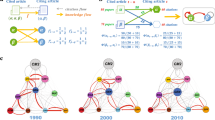Abstract
The fundamentals have been developed for a quantitative theory on the structure and dynamics of scientific networks. These fundamentals were conceived through a new vision of translation, defined mathematically as the derivative or gradient of the quality of the actors as a function of the coordinates for the space in which they perform. If we begin with the existence of a translation barrier, or an obstacle that must be overcome by the actors in order to translate, and if we accept the Maxwell-Boltzmann distribution as representative of the translating capacity of the actors, it becomes possible to demonstrate the known principle of “success breeds success.” We also propose two types of elemental translation: those which are irreverisble and those which are in equilibrium. In addition, we introduce the principle of composition, which enables, from elemental translations, the quantification of more complex ones.
Similar content being viewed by others
References
Small, H., Co-citation in the scientific literature: a new measure of the relationship between two documents.Journal of the American Society for Information Science, 24 (1973). No. July–August, 265–269.
Callon, M., Law, J., Rip, A., Eds.,Mapping the dynamics of science and technology: Sociology of science in the real world. London: Mc Millan Press LTD., 1986.
Callon, M., Courtial, J.P., Laville, F., Co-word analysis as a tool for describing the network of interactions between basic and technological research: the case of polymer chemistry.Scientometrics, 22 (1991), No. 1, 155–205.
Courtial, J.P.,Introduction à la scientométrie. De la bibliométrie à la veille technologique. Paris: Anthropos, 1990.
Latour, B., Woolgar, S.,Laboratory Life. London, Sage, 1979.
Latour, B.,Science in action. Cambridge: Harvard University Press, 1987.
Courtial, J.P., Callon, M., Sigogneau, A., The use of patent titles for identifying the topics of invention and forecasting trends,Scientometrics, 26 (1993) No. 2, 231–242.
Ruiz-Baños, R.,Ciencimetría de Redes. Análisis de la investigación internacional sobre Arqueologia mediante el Método de las Palabras Asociadas (1980–1993), doctoral thesis. Granada, 1997.
Price, D.,Little Science, Big Science, New York: Columbia University Press, 1963.
Kuhn, T.S.,The Structure of Scientific Revolutions, Chicago: The University of Chicago Press, 1970, 2nd ed.
Courtial, J.P., Gourdon, L., A Scientometric approach to autismo based on Translation Sociology,Scientometrics, 40 (1997) No. 2, 333–355.
Goody, J.,La Raison graphique. La domestication de la pensée sauvage. Minuit (trad.), 1979.
Latour, B.,Nous n'avons jamais modernes, La Découverte, 1991.
Courtial, J.P., Gourdon, L., Mapping the Dynamics of Research on Autism, Paper submitted toTheory and Psychology, 1998.
Courtial, J.P., Rocher, Y., L'analyse d'un collectif à travers l'exemple d'un domaine de recherche,Journées d'Etude du Centre de Sociologie de l'Ecole des Mines de Paris, 9–10, mai, 1996.
Harrison, A.,Fractal in Chemistry. Oxford University Press, 1995.
Author information
Authors and Affiliations
Rights and permissions
About this article
Cite this article
Ruiz-Baños, R., Bailón-Moreno, R., Jiménez-Contreras, E. et al. Structure and dynamics of scientific networks. Part I: Fundamentals of the quantitative model of translation. Scientometrics 44, 217–234 (1999). https://doi.org/10.1007/BF02457381
Received:
Issue Date:
DOI: https://doi.org/10.1007/BF02457381




